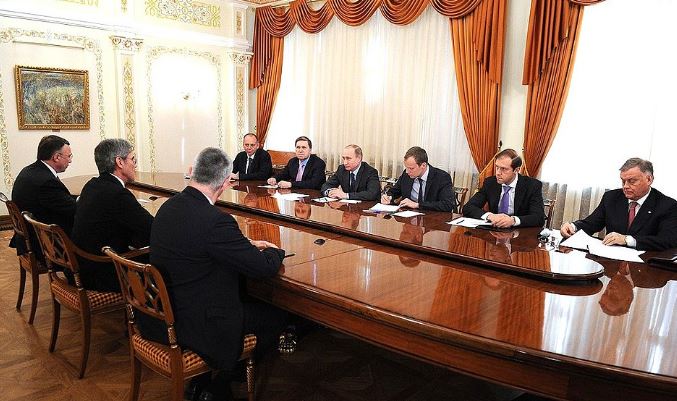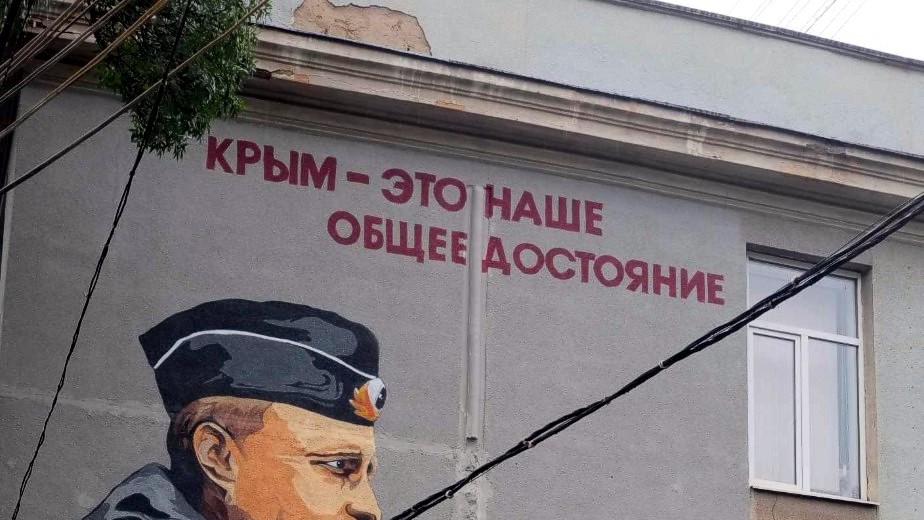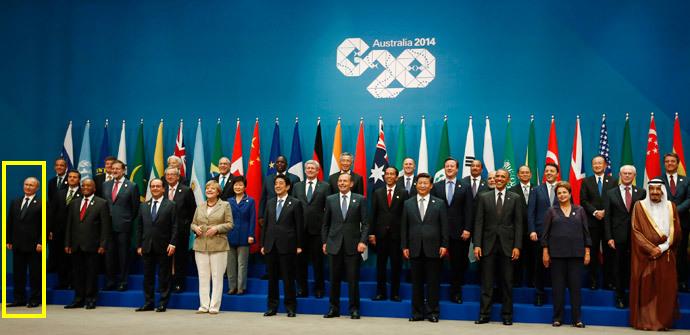On 23 September 2017, Siemens‘ CEO Joe Kaeser gave an interview with the German outlet Spiegel in which he said that, despite Siemens’ 160-year “relationship of trust” with Russia being “burdened” with Siemens gas turbines ending up in two power plants under construction in occupied Crimea in July 2017, a “whole country with its loyal and reliable” customers can’t be blamed for violating EU sanctions and helping Russia secure its occupation of the peninsula, and the German techno giant shouldn’t “overreact.”
He said this answering a question whether he felt he had been deceived by Russian President Vladimir Putin, who, according to the German newspaper WirtschaftsWoche, had promised the German Foreign Minister that the turbines, produced on factory jointly owned by Siemens and the Russian company Power Machines that the turbines would not end up in Crimea, which before being occupied by Russia in 2014 was energy reliant upon mainland Ukraine.
After the turbines finally ended up in Crimea, Siemens’ claimed it was innocent, had been duped by its Russian partner OAO Technopromexport, and was confident until the very end that the turbines are being produced for a power station in the Taman peninsula. In this interview, Joe Kaeser repeated that claim. We decided to fact-check his statements with the help of our open-source investigation How Siemens chose to ignore the obvious. An investigation into the Crimean sanctions break.

SPIEGEL: There have been indications for a long time that from the outset the gas turbines were not intended for a faked power plant project on the Russian mainland, but for Crimea. Were you too gullible, naive, innocent, careless or all of them together?Kaeser: Of course you are always wiser afterward. We found ourselves in a quite plausible situation: we had clear contractual partners, there was project financing and a designated building site that already had some initial preparations…
SPIEGEL:… on which no crumb of earth was moved.
Kaeser: This only became apparent after the aggregates had been purchased long ago. – Spiegel
“Clear contractual partners.” The only clear thing about Siemens’ partner was that it was building two power stations in occupied Crimea. On 10 March 2015, Siemens signed a contract with OAO Technopromexport, a Russian company with 100% of shares belonging to the state-owned Rostec technological monopoly. At the moment of signing, Rostec chief Sergei Chemezov was six months since under EU sanctions for OAO Technopromexport’s plans to build energy plants in Crimea, which were announced on 21 August 2014. As well, Rostec itself was six months under US sanctions.
The contract to produce 7 gas turbines, four of which were produced, for a power plant in the Taman peninsula on 10 March 2015 was made secretly and bypassed the state tender system required for state companies, in violation of Russian law. It only came to light after the publication of the Russian outlet Vedomosti based on insider testimonies on 30 June 2015, after which Siemens was forced to confirm that such a contract in fact existed, and assured they had no reason to believe the turbines were destined for Crimea. Afterwards, the process of constructing the Sevastopol and Simferopol power plants in Crimea was suddenly and without any comment taken over by OAO Technopromexport’s Rostec-owned clone, OOO Technopromexport, which started placing tenders to construct power plants with parameters identical to the SGT5-2000E turbines Siemens had sold in March. It was this OOO Technopromexport which secretly bought the turbines from OAO Technopromexport in 15 October 2015. Siemens is now suing both companies for an alleged breach of contract.

“There was project financing.” The contract Siemens concluded in March 2015 specified that the Siemens turbines will be made for a projected power plant to be built on the territory of Krasnodar Krai (project “Taman”). However, at that moment there were no clear government plans for any power plant in that region, much less an investor or financing.
Although on 22 December 2014, Russian Energy Minister Aleksandr Novak said in an interview to Kommersant that apart from 2 power plants in Crimea, a power station in Taman with a capacity of 660 MW will be built to “increase the reliability of energy supply to Crimea.” Notably, the four gas turbines Siemens had sold for this supposed station were “oversized” for it: they are designed to be used in power stations with a 940 MW, i.e. 30% more electricity than specified in the Russian government’s vague plans.
These vague plans were not included in Russia’s framework document on energy construction, namely – the instruction #627 “On the confirmation of the scheme and program development of the United Energy System of Russia for 2015-2021” issued by the Russian Ministry of Energy six months later, on 9 September 2015. It contains no mention of a gas power plant to be constructed in Taman, but specifies that two such power plants will be built in Crimea, with a total capacity of 940 MW, which exactly fits the Siemens SGT5-2000E turbines.
Aleksandr Novak first announced that Russia was searching for an investor for the supposed power station in Taman on 19 January 2016, stating that the projected capacity was decreased to 450 MW, now less than 50% of the capacity which the Siemens turbines were designed for. However, the contest, which was finished on 24 June 2016, ended without a result – no investor showed interest. A new contest is being mulled only now. Under these circumstances, OAO Technopromexport’s purchase of the turbines from Siemens made close to zero business sense. If only they were not being bought for the power stations in Crimea, the construction of which was financed by the Russian government, and, later in July 2016, by a loan from the bank RNKB.

“Designated building site.” No information about a specific building site for the hypothetical power plant in Taman is available from open sources. As the said plant did not, and does not have an investor yet, and was not part of any government plans, it’s very likely that there was none. Internet searchers and The first time that a specific location for the supposed plant in Taman comes up is a DW publication on 10 October 2016, in which a Siemens official in Munich mentions that the March 2015 contract envisioned using the turbines near the village stanitsa Rayevsakaya in Krasnodar Krai. Apart from these allegations by Siemens, which have been reproduced by numerous media, there is no mention of a power plant project at stanitsa Rayevskaya in any official documents, development plans, energy supply maps or the like. And this despite the fact that it would be a major project with no less than 4 combined-cycle turbine units of 235 MW each.

Moreover, two tenders that OOO Technopromexport submitted on 31 March 2016 to the state tender system zakupki.gov.ru to “develop and deliver a software and hardware complex for the automated control system of two power plants in Taman” with an overall capacity of 940 MW, i.e. two times less than the 450 MW which was voiced over by the Energy Minister, left the physical construction address blank.
These tenders are a nearly identical copy from two submitted (and canceled, citing the necessity to change the “Terms of Reference”) tenders for the power stations under construction in occupied Sevastopol and Simferopol, save for the address and climatic parameters. There is little doubt that the tenders for the hypothetical “Taman1” and “Taman2” with no construction address were, in fact, a cover-up operation for providing services to occupied Crimea, most probably – to help Rosatom, an institute of which won the tenders, to avoid sanctions.
Notably, one of the bidders for the canceled tenders (1, 2) for the “software-hardware complex for the automated control system of power plants” in Sevastopol and Simferopol on 29 January 2016, was ZAO Interautomatika, a company with 45.72% of shares owned by Siemens! This company is reportedly involved in helping make the power plants operational in Crimea. Amid the media scandal caused by the delivery of its turbines to Crimea, Siemens withdrew from ZAO Interautomatika and it is under EU sanctions now.
Siemens did everything it could?
Kaeser: …The order was booked in the second calendar quarter of 2015. Until the handover of the turbines in August 2016, we had investigated rumors about an alleged operation in Crimea very carefully but found no evidence of this. The customer has confirmed the destination several times in writing, most recently immediately before delivery. Only after that were there indications of a potential change in destination, and we stopped all further deliveries. However, it was already too late for the turbines, we no longer had physical control. – Spiegel
By now, the reader can already outline many things pointing to evidence of an alleged operation in Crimea:
- OAO Technopromexport’s declaration that it will construct two power plants in Crimea in accordance with government plans, sanctions slapped by the EU and US on Rostec’s chief for this very reason;
- These two power plants having exactly identical technical parameters to the turbines Siemens sold to OAO Technopromexport;
- The absence of any official government plans to build a power station in the Taman peninsula, only vague statements by government officials about this hypothetical station, outlining a capacity which was first 1/3, then 1/2 smaller than the capacity of the turbines Siemens sold it, the absence of an investor and contest for this station;
- A “clone” of OAO Technopromexport taking over the construction of power stations in Crimea after media coverage of Siemens’ secret contract to provide turbines to the company;
- Tenders for the “software-hardware complex for the automated control system of power plants” were first submitted for the two power stations in occupied Crimea, to which a Siemens-owned company had applied, and then resubmitted with the exact technical parameters as tenders for two (sic!) power plants in Taman, with no construction address.
Additional evidence of an operation in Crimea is provided by the fact that Siemens made no reaction to the bankruptcy proceedings of its partner OAO Technopromexport in February 2016. Bankruptcy was the reason that OAO Technopromexport gave when explaining why it didn’t take part in the contest for investors for the Taman power plant in June 2016, and the reason why it attempted to (unsuccessfully) auction off the turbines on 16 September 2016.
Informed sources with access to the contract Siemens signed with OAO Technopromexport told Euromaidan Press that the contract, apart from a clause specifying that the turbines can only be used at the power plant in Taman, stipulated a no-resale clause. By February 2016, it became obvious that Siemens’ client has dubious prospects. Nevertheless, Siemens proceeded with the deal and delivered the turbines, even though the client would be able to neither legally sell them nor install them in the so far only hypothetical power station. As well, Siemens took no note of the auction, which violated its contract with OAO Technpromexport.
- Why did Siemens conclude a secret deal with shady partners under EU sanctions?
- Why didn’t Siemens notice that the proposed station was absent in any government plans, had no investor, no construction site?
- Why didn’t Siemens notice that its turbines were “oversized” for the vague ideas for the hypothetical Taman power plant that did exist?
- Why did Siemens’ subsidiary take part in a contest to develop software for the stations in Crimea?
- Why did it have no plan in case the contract would be abused, a scenario which was more than likely?
- Why did Siemens agree to sell turbines even to a hypothetical station in Taman in the first place, which even if constructed would contribute to the power bridge from Russia to occupied Crimea
Perhaps the answers to those questions lie in Siemens’ special relationship with Russia. On 26 March 2014, 10 days after the illegitimate referendum securing Russia’s annexation of Crimea, Kaeser attended a meeting discussing business operations with Putin. The Kremlin’s official press service does not tell of talks about Crimea being held at this meeting. After his visit to the Russian capital, Kaeser explained in a televised interview with the German channel ZDF that the visit was planned long ago, and that “short-term turbulence” in the relations between the countries should not impact plans to collaborate with Russia. “We count on a dialogue and mutual understanding,” he said after the trip, adding that German Chancellor Angela Merkel knew about it aforehand.

Merkel admonished Kaesar for this trip and declared that “German companies shouldn’t sell European values for the sake of business in Russia.” She was supported by then Economy and Energy Minister Sigmar Gabriel, now Minister of Foreign Affairs. “We do not want economic sanctions, but we also want to show the Russian president that we can’t accept his imperial policies,” he said.
After the media uproar with the delivery of Siemens turbines to Crimea, three Russian officials and three Russian companies – OAO Technopromexport, OOO Technopromexport, and ZAO Interautomatika – were placed under EU sanctions. But Siemens is passing itself off as a law-abiding company betrayed by Russian partners and has carried no responsibility for its criminal negligence, or intent, or both, that led to the turbines being delivered to occupied Crimea. It has announced that it is ready to modernize the existing Russian power plants. Joe Kaeser and other German executives are set to meet Vladimir Putin on October 12.
There is more than enough evidence testifying that Siemens knew its turbines will help secure Russia’s imperial landgrab. A criminal investigation has to be opened into its actions now.
Read also:
- How Siemens chose to ignore the obvious. An investigation into the Crimean sanctions break
- Siemens’ Crimea sanctions break – a case of criminal negligence | #SiemensGate
- Two more Siemens turbines delivered to occupied Crimea by same company
- Powering the Anschluss. How Siemens turbines ended up in Crimea despite sanctions
- Siemens set to violate sanctions regime, helping build power stations in Crimea
- Siemens to help provide forbidden power to Crimea
- Russian-German nur geschäft, or strategy for bypassing sanctions








